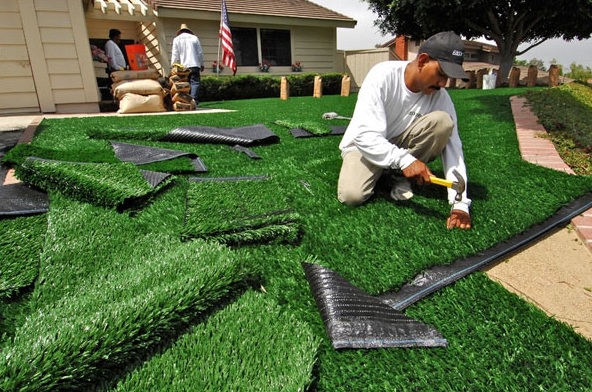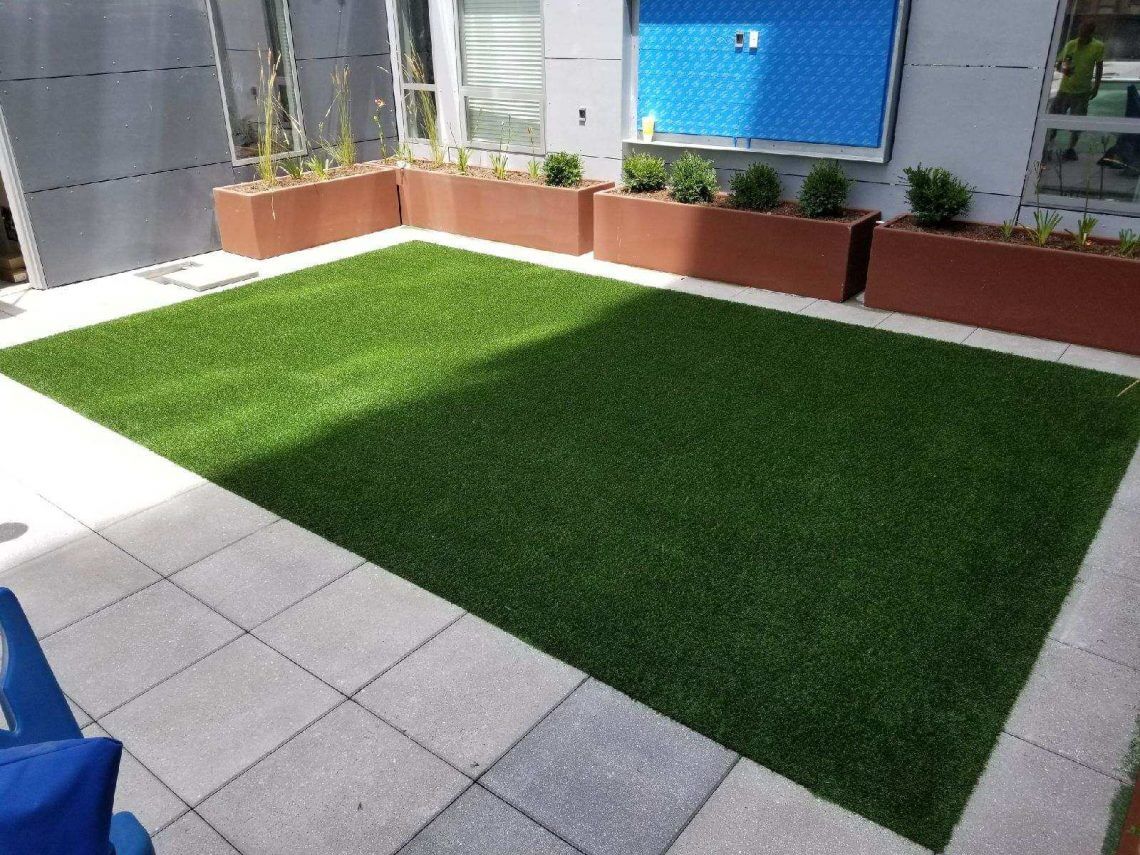Backyard Artificial Grass Canoga Park: Elevate Your Outdoor Space
Backyard Artificial Grass Canoga Park: Elevate Your Outdoor Space
Blog Article
Leading Factors to Consider Artificial Yard for a Low-Maintenance and lavish Backyard
As homeowners significantly look for lasting remedies for outside areas, synthetic lawn provides an attractive option to traditional yards. Its capability to preserve a dynamic appearance year-round without the problems of mowing, watering, or chemical treatments makes it a practical choice for those aiming to reduce maintenance efforts. The ecological advantages, including significant water preservation and reduced dependence on chemicals, straighten with contemporary ecological worths. Nonetheless, the benefits prolong beyond plain aesthetics and sustainability; checking out the multifaceted implications of fabricated lawn reveals a comprehensive approach to lawn administration that merits much deeper factor to consider.
Year-Round Greenery
Among one of the most considerable benefits of man-made grass is its ability to give year-round plant, no matter of climate problems. Home owners frequently face challenges in keeping a dynamic lawn as a result of seasonal changes, dry spells, or heavy rainfall. Fabricated lawn eliminates these worries, making certain a consistently lavish look throughout the year.
This synthetic option is crafted to withstand different climate situations, from sweltering summertime warm to cold wintertime temperature levels. Unlike all-natural yard, which might brownish or end up being uneven throughout extreme problems, synthetic grass preserves its lively shade and texture, boosting the visual allure of any type of landscape.
Additionally, man-made lawn is resistant to pests and conditions that typically influence natural lawns. This resilience contributes to its enduring appeal, as there is no need for chemical therapies or fertilizers that can be harmful to the setting. Furthermore, property owners can appreciate the visual advantages of a well-kept lawn without the intermittent challenges positioned by all-natural grass care (artificial grass).
Lowered Maintenance Initiatives
Man-made grass dramatically reduces maintenance efforts, enabling homeowners to appreciate a beautiful yard without the lengthy jobs connected with natural grass care. One of the most notable benefits of artificial turf is the elimination of routine mowing. With no demand for a lawnmower, homeowners save both time and the price of upkeep related to this tools.

Cleansing fabricated turf is uncomplicated; an easy rinse with a tube or the periodic brushing to get rid of particles is typically enough - artificial grass installation. This ease of treatment allows property owners to invest even more time enjoying their outside spaces as opposed to struggling over them. In recap, the lowered maintenance initiatives connected with synthetic lawn make it an enticing selection for those seeking a lovely, hassle-free yard
Water Conservation Perks
The substantial decrease in upkeep efforts related to fabricated yard encompasses water conservation, making it an eco-friendly alternative for homeowners. Traditional lawns need considerable amounts of water to stay dynamic and lush, commonly bring about too much water use, especially in deserts. In comparison, fabricated yard removes the requirement for routine watering, drastically reducing the overall water intake in your backyard.
By selecting synthetic grass, property owners can save thousands of gallons of water each year. This change not just advantages private homes but additionally adds to broader ecological initiatives webpage targeted at minimizing water waste. In areas experiencing water deficiency, the fostering of synthetic turf can play a significant duty in alleviating the results of dry spell and guaranteeing that valuable water sources are used more effectively.
In addition, the setup of artificial yard can assist reduced municipal water need, benefiting the area all at once. With growing awareness of ecological problems, picking man-made grass acts as a proactive action towards lasting landscaping, aiding to preserve natural water resources while maintaining a visually pleasing exterior room (artificial grass). In recap, artificial lawn presents a compelling remedy for water conservation, aligning ecological responsibility with contemporary landscape design needs

Bug and Allergic Reaction Reduction
A substantial benefit of mounting artificial grass is its ability to reduce insects and allergens in outdoor spaces. Typical yard yards typically function as reproducing grounds for insects such as insects, ticks, and ants, which can produce discomfort and health and wellness threats for pets and family members. On the other hand, man-made yard eliminates the natural material that draws in these parasites, therefore dramatically reducing their populaces in your lawn.
Furthermore, natural yard can nurture mold, plant pollen, and other irritants, which can activate allergic reactions and respiratory problems for sensitive people. Synthetic grass offers a cleaner setting, minimizing the potential for allergenic responses. Unlike natural lawn, synthetic grass does not produce plant pollen, making it an excellent alternative for allergy victims seeking to appreciate their outdoor areas without the threat of flare-ups.
Furthermore, the lack of soil in artificial grass means there is less dirt and dust, additional decreasing air-borne allergens. This low-maintenance option not just enhances the aesthetic charm of your yard however additionally promotes a healthier outside environment, enabling family members to enjoy their yards without the continuous fear of insects and irritants. Therefore, fabricated grass is a calculated option for those focusing on convenience and health and wellness in their outside home.
Long-Term Expense Financial Savings
Buying artificial grass can bring about considerable lasting cost financial savings for homeowners. While the first investment might seem substantial, the financial advantages in time can be substantial. Synthetic yard removes the need for normal grass maintenance expenditures, such as mowing, fertilizing, and watering. Conventional yards frequently need substantial resources to maintain a rich appearance, specifically in areas vulnerable to dry spell or severe climate condition.
Moreover, the durability of synthetic lawn further boosts its cost-effectiveness. A lot of high-grade artificial turf items can last 15 to 25 years with minimal upkeep, minimizing the requirement for replacement or considerable repair work. In comparison, natural yard may call for frequent reseeding and routine care, which can quickly include up in prices.
Utility financial savings are one more important element. Property owners can why not check here expect to see reduced water costs, as synthetic lawn does not need watering. Additionally, the reduction in grass treatment solutions can release up valuable time and sources, permitting homeowners to designate their spending plans in other places.
Verdict
In summary, artificial turf offers numerous benefits for homeowners seeking a low-maintenance and dynamic landscape. their explanation Inevitably, the long-term cost financial savings linked with artificial turf solidify its status as a sensible and lasting remedy for boosting exterior rooms.
Fabricated turf substantially lowers upkeep initiatives, enabling house owners to appreciate a pristine lawn without the time-consuming jobs linked with all-natural lawn treatment.The considerable reduction in maintenance efforts linked with fabricated yard extends to water conservation, making it an ecologically friendly option for home owners. In comparison, man-made lawn removes the requirement for routine watering, drastically lowering the total water intake in your yard.
In areas experiencing water deficiency, the fostering of synthetic grass can play a substantial duty in reducing the effects of dry spell and guaranteeing that valuable water sources are used extra efficiently.
With expanding understanding of environmental concerns, choosing man-made turf offers as a positive step in the direction of sustainable landscape design, helping to preserve all-natural water resources while preserving an aesthetically pleasing outside space.
Report this page